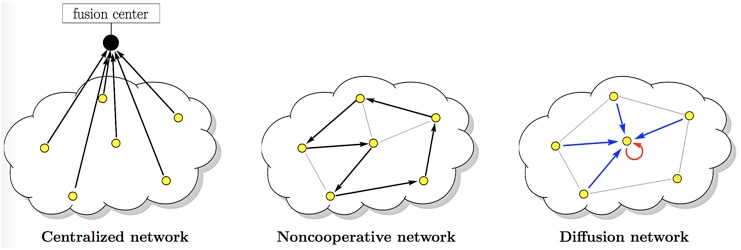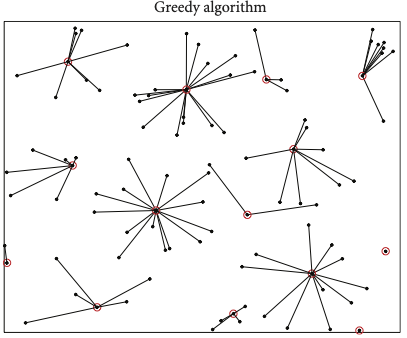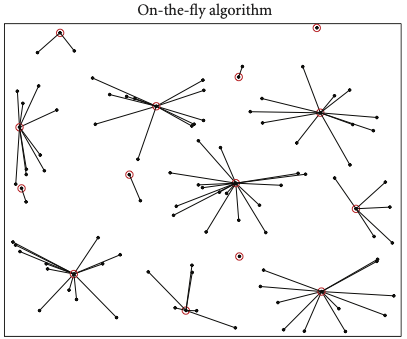
Scientific Challenge
Collaborative information processing in sensor networks is becoming a very active field of research. Within conventional (centralized) sensor networks, sensors are only confined the role of collecting information measurements, while these data are collected through the network, and processed within a central unit, also known by the fusion center. Recent research reveals a new generation of sensors becoming more intelligent. These so-called smart sensors have the ability to collaborate with each other, by exchanging information in order to ensure optimal decision. As opposed to the centralized scheme, the proposed approach does not rely on a unique central processing unit whose damaging may lead to the failure of the entire system. The resulting system is thus very robust against a technical failure of the central unit or some sensors. Moreover, as information is collected and processed locally, within each sensor or within clusters of them, only relevant data are exchanged between smart sensors, hence, limiting the required channel communication bandwidth.
Wireless ad-hoc sensor networks have emerged as an interesting and important research area in the last few years. Wireless sensor networks cover a large spectrum of envisioned applications, varying from monitoring inhospitable habitats and disaster areas to operating indoors for intrusion detection and equipment monitoring. Many communities are interested with the potential applications of these wireless sensor networks, and supporting future applications including military surveillance and tracking abilities. The building block of these networks is a wireless sensor mote, as with the Mica2 motes from Crossbow (see figure) used in our lab, with embedded sensing capabilities, memory and processing unit, as well as a wireless communication module and a power supply. Low cost and miniaturization of sensor nodes involve limited computational resources, power and communication capacities. Consequently, wireless ad hoc sensor networks require collaborative execution of a distributed task amongst a large set of motes.
Current Studies
Decentralized decision-making have been the focus of considerable research in the last decade. The large majority of the literature is based on the assumption that the probability distributions of the sensor observations lie within some known parametric family and seek to characterize the structure of optimal decision rules. Of course, this raises the question of how to determine an appropriate parametric family, and how to estimate parameters. Recent works in statistical machine learning have demonstrated the power and versatility of kernel-based methods for learning a problem on the basis of empirical data sets. This approach has been used successfully in a large class of problems, to name a few, spanning from the estimation of binary functions for detection and decision-making (with novelty detection techniques such as the one-class Support Vector Machines), to classification (Support Vector Classifier and kernel-based Fisher discriminant analysis), to functional estimation (Support Vector Regression and kernel-based least-squares methods), as well as unsupervised or non-labelled data learning (kernel-based Principal Component Analysis).
Most kernel machines are statistical learning algorithms that take advantage of the geometric and regularizing properties of reproducing kernel Hilbert spaces (RKHS). A key property behind such algorithms is that they can be expressed in terms of inner products only, involving pairs of input data. Replacing these inner products with a reproducing kernel provides an efficient way to implicitly map the data into a high, even infinite, dimensional RKHS and apply the original algorithm in this space. Because calculations are then carried out without making direct reference to the non-linear mapping of input data, this principle is commonly called the kernel trick. Kernel-based algorithms are computationally very efficient, and generally have their generalization performance guaranteed by the Statistical Learning Theory. Nevertheless, most kernel machines consider essentially centralized approaches to solve the learning problem, and therefore are not suitable for distributed learning in sensor networks.
We propose machine learning techniques for collaborative learning in wireless sensor networks, taking into account the limited resources in computation, memory usage, communication as well as power. We are interested in wireless sensor networks deployed in an environment to sense for modeling and monitoring given physical phenomena, such as gas, pollution, biochemical, temperature, humidity, acoustic field, motion, etc. It is worth noting that collaborative learning greatly enhances the accuracy of the estimation, and the detection performance.
We have been working on these problems for more than 10 years. Our main contributions are described in the following, chronologically from newer to older, with some selected publications:
- Recent Advances in Estimation and Evolution Tracking with Wireless Sensor Networks (2014-2017)
- In-network (on-the-fly) Principal Component Analysis (2013-2016)
- Wireless Sensor Networks: Estimation and Evolution Tracking with Collaborative Learning (2008-2013)
Recent Advances in Estimation and Evolution Tracking with Wireless Sensor Networks (2014-2017)
Detection and estimation of the parameters of multiple gas sources in wireless sensor networks:
Sandy Mahfouz, Farah Mourad-Chehade, Paul Honeine, Joumana Farah, and Hichem Snoussi
Gas Sources Parameters Estimation Using Machine Learning in WSNs.
IEEE sensors journal, 16 (14), 5795-5804, July, 2016
Distributed estimation in intelligent camera networks, with an application on abnormal event detection:
Tian Wang, Jie Chen, Paul Honeine, and Hichem Snoussi
Abnormal event detection via multikernel learning for distributed camera networks.
International Journal of Distributed Sensor Networks, Article ID 989450, 1-9, 2015
Optimal mobility for the sensors for the spatial regression:
Nisrine Ghadban, Paul Honeine, Farah Mourad-Chehade, Clovis Francis, and Joumana Farah
Mobility using first and second derivatives for kernel-based regression in wireless sensor networks.
Proc. 21st International Conference on Systems, Signals and Image Processing (IWSSIP), Dubrovnik, Croatia, 12-15 May, 2014
In-network (on-the-fly) Principal Component Analysis (2013-2016)
(Work of PhD Student Nisrine Ghadban)
Principal component analysis is a very well-known statistical analysis technique. It determines principal axes that allow relevant data reduction. Thus, it is very useful in networks where a large number of measures is performed. However, such a technique needs high-complexity computation, which does not scales well in large networks. Our work proposes to overcome this issue, by describing several in-network strategies that estimate the principal axes with lower computational complexity. These strategies are either noncooperative or cooperative with information diffusion. The performance of the proposed strategies are illustrated on diverse applications, such as image processing and dimensionality reduction of time series in wireless sensor networks.
This is the first time that collaborative learning is considering an unsupervised learning problem.
Nisrine Ghadban, Paul Honeine, Farah Mourad-Chehade, Clovis Francis, and Joumana Farah
In-network Principal Component Analysis and Diffusion Strategies.
International Journal of Wireless Information Networks, 23 (2), 97-111, June, 2016
Nisrine Ghadban, Paul Honeine, Farah Mourad-Chehade, Joumana Farah, and Clovis Francis
Gossip algorithms for principal component analysis in networks.
Proc. 23rd European Conference on Signal Processing (EUSIPCO), Nice, France, pp. 1-5, 31 Aug.-4 Sept., 2015
Nisrine Ghadban, Paul Honeine, Clovis Francis, Farah Mourad-Chehade, and Joumana Farah
Strategies for principal component analysis in wireless sensor networks.
Proc. 8th IEEE Sensor Array and Multichannel Signal Processing Workshop (SAM), A Coruña, Spain, 22-25 June, 2014
Nisrine Ghadban, Paul Honeine, Farah Mourad-Chehade, Clovis Francis, and Joumana Farah
Diffusion Strategies For In-Network Principal Component Analysis.
Proc. 24th IEEE workshop on Machine Learning for Signal Processing (MLSP), Reims, France, pp. 1-6, 21-24 Sept., 2014


Wireless Sensor Networks: Estimation and Evolution Tracking with Collaborative Learning (2008-2013)

Nisrine Ghadban, Paul Honeine, Clovis Francis, Farah Mourad-Chehade, Joumana Farah, and Maya Kallas
Estimation locale d’un champ de diffusion par modèles à noyaux.
Actes de la 14-ème conférence de Recherche Opérationnelle et Aide à la Décision (ROADEF), Troyes, France, 13-15 Fév., 2013
François Septier, Yves Delignon, Patrick Armand, Hichem Snoussi, and Paul Honeine
MALICE : Localisation de sources polluantes depuis un réseau de capteurs.
4-ème Workshop du Groupement d’Intérêt Scientifique : Surveillance, Sûreté, Sécurité des Grands Systèmes (GIS-3SGS’11) Valenciennes, France, pp. 1, 12-13 Oct. 2011
Paul Honeine, Cédric Richard, Hichem Snoussi, José C. M. Bermudez, and Jie Chen
A decentralized approach for non-linear prediction of time series data in sensor networks.
Journal on Wireless Communications and Networking (EURASIP), Hindawi Publishing Corp., NY, USA, pp. 12:1-12:12, Jan., 2010
Jie Chen, Cédric Richard, Paul Honeine, and José C. M. Bermudez
Non-negative Distributed Regression for Data Inference in Wireless Sensor Networks.
Proc. 44th Asilomar Conference on Signals, Systems, and Computers (Asilomar), Pacific Grove (CA), USA, pp. 451-455, 7-10 Nov., 2010
Cédric Richard, Paul Honeine, Hichem Snoussi, André Ferrari, and Céline Theys
Distributed learning with kernels in wireless sensor networks for physical phenomena modeling and tracking.
Proc. IEEE International Geoscience and Remote Sensing Symposium (IGARSS), Honolulu (Hawaii), USA, 25 – 30 July, 2010
Mehdi Essoloh, Paul Honeine, Cédric Richard, and Hichem Snoussi
Apprentissage non-linéaire en ligne dans les réseaux de capteurs sans fil.
Actes du 22-ème Colloque GRETSI sur le Traitement du Signal et des Images (GRETSI’09), Dijon, France, Sept., 2009
Paul Honeine, Cédric Richard, José C. M. Bermudez, Hichem Snoussi, Mehdi Essoloh, and François Vincent
Functional estimation in Hilbert space for distributed learning in wireless sensor networks.
Proc. 34th IEEE International Conference on Acoustics, Speech and Signal Processing (ICASSP), Taipei, Taiwan, pp. 2861-2864, April, 2009
Paul Honeine, Cédric Richard, José C. M. Bermudez, and Hichem Snoussi
Distributed prediction of time series data with kernels and adaptive filtering techniques in sensor networks.
Proc. 42nd Annual ASILOMAR Conference on Signals, Systems and Computers (Asilomar), Pacific Grove, CA, USA, pp. 246-250, Oct., 2008
Paul Honeine, Mehdi Essoloh, Cédric Richard, and Hichem Snoussi
Distributed regression in sensor networks with a reduced-order kernel model.
Proc. 51st IEEE GLOBECOM Global Communications Conference, New Orleans, LA, USA, pp. 1-5, 2008